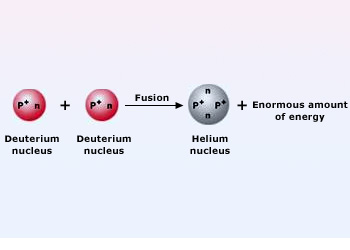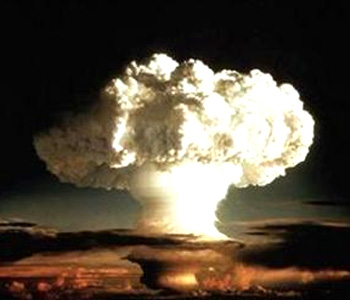 Nuclear Fusion
Nuclear Fusion
The word ‘fusion’ means ‘to join’ or ‘to combine’, so nuclear fusion means joining together of nuclei of atoms. Just as we split a big nucleus into smaller nuclei during fission, we combine together smaller nuclei to form big nucleus in fusion. Thus, a fusion process is just the reverse of fission. We can now say that: the process in which two nuclei of light atoms (like that of hydrogen) combine to form a heavy, more stable nucleus (like that of helium), with the liberation of a large amount of energy is called nuclear fusion.
There is some loss of mass during the fusion process, which produces a tremendous amount of energy. The energy produced in nuclear fusion reaction is much more than that produced in a nuclear fission reaction. When deuterium atoms (heavy hydrogen atoms of mass number 2) are heated to a very high temperature, then two deuterium nuclei combine together to form a heavy nucleus of helium, and an enormous amount of energy is liberated.
 The hydrogen Bomb
The hydrogen Bomb
The fusion reactions can, however, be initiated by using the heat evolved in a fission reaction but in this way, the fusion of hydrogen gets out of control and leads to an explosion of what is called a hydrogen bomb. There is a greater loss of mass in a fusion reaction than a fission reaction, and hence the energy produced in a fusion reaction is much more than that produced in fission reaction. In fact, the energy produced in a nuclear fusion reaction is so great that it has not been possible to control it so far, to be used for peaceful purposes like the generation of electricity.
A hydrogen bomb is, by far, the most destructive weapon that mankind has ever invented. It is the most powerful type of nuclear bomb, nearly 25,000 times the yield of the nuclear bombs dropped on Hiroshima and Nagasaki, Japan. Unlike conventional atom bombs (also known as A–bombs), which release energy by fissioning heavy atomic nuclei like uranium and plutonium, a hydrogen bomb releases energy by fusing together light nuclei like tritium or deuterium, converting even more matter into energy. Wen Truman authorized the dropping of the A–bomb on Hiroshima and Nagasaki, he said that the weapons used the same power that the Sun did, but that wasn't actually true the Sun uses nuclear fusion, not nuclear fission. Thus, a hydrogen bomb really does release the power that fuels the Sun.